Pantone 2025 Color of the Year: Infusing Mocha Mousse into Your Home
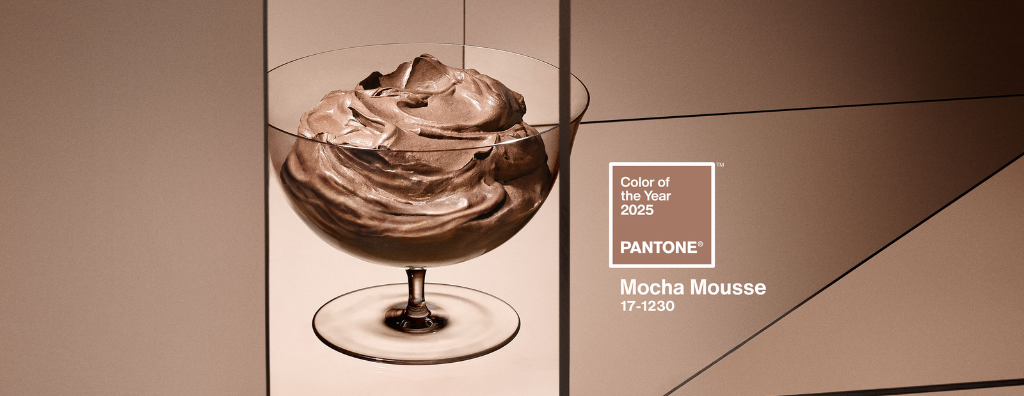
Another year, another reason to repaint. Pantone, the global authority on color, has announced its 2025 Color of the Year, “Mocha Mousse.” And as this year’s interior design trends lean towards more earthy tones, this creamy, rich brown is set to be everywhere—from your morning coffee to your neighbor’s curtains. Whether aiming to create a relaxing and warm sanctuary or add a refined accent to your home, Mocha Mousse is the perfect color to set the mood. Check out these creative and stylish ways to introduce this timeless color into your home and elevate your atmosphere.
Pantone Color of the Year: Mocha Mousse
PANTONE 17-1230 Mocha Mousse is a warm, muted brown with creamy undertones inspired by the decadent qualities of chocolate mousse and coffee. Chosen for its perfect balance of richness and warmth, Pantone describes Mocha Mousse as reflecting our collective desire for comfort, indulgence, and connection. Its smooth and inviting tones combine sophistication with coziness, making it a versatile neutral color that can enhance any space.
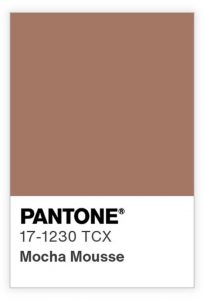
How to Use Mocha Mousse in Your Home
Mocha Mousse follows the latest interior design trends that embrace earthy, neutral tones. From minimalist to eclectic, it pairs beautifully with various styles, materials, and color palettes, ideal for any room needing a warm hug. Whether used on accent walls, in textiles like throw pillows and drapes, or through smaller décor details, Mocha Mousse infuses spaces with elegance and a soothing ambiance.
Harmonizing Mocha Mousse with Complementary Color Pairings
Mocha Mousse isn’t just a color—it’s a mood setter, harmoniously blending with many design styles and color schemes. Pantone’s color enthusiasts created five unique palettes featuring the versatile hue, each designed to evoke a different mood. These palettes included a serene, airy combination of soft neutrals in “Relaxed Elegance,” calming, nature-inspired tones like willow green in “Floral Pathways,” and vibrant, exotic contrasts in “Uniquely Balanced.”
Using their expertly curated color stories and suggested harmonies, you can easily integrate the delicious 2025-color Mocha Mousse into your home’s existing color palette. For instance, it compliments warm tones like deep reds, pinks, or soft oranges, adding depth without overwhelming the space. If you have cooler shades like blues and greens, Mocha Mousse will balance these tones, creating a more grounded space. For a more subtle touch, you can also pair it with natural wood tones, light grays, or delicate creams to enhance its elegance. If you want to explore more color options that fit your style, check out these 11 Ways to Uncover Your Personal Color Palette.
Using Mocha Mousse with Interior Design Trends of 2025
Earthy, neutral tones are here to stay in 2025, and Mocha Mousse is leading the charge with its grounding, warm appeal. With brown furniture also remaining a strong trend, this hue can complement rich wood and leather pieces, adding comfort and sophistication. It beautifully blends with natural materials like stone, wood, and ceramics, enhancing modern, rustic, and bohemian interiors, along with many others. Similarly, Mocha Mousse pairs well with metals and verdigris, which have become increasingly popular.
Mocha Mousse naturally complements the curvier lines, soft shapes, and rounded furniture pieces that are defining 2025. It can be easily into spaces with arched doorways and rounded furniture to create a polished, inviting environment. You can also embrace it with the comeback of wallpaper, upholstered walls, and drapery, whether in subtle patterns or rich textures like suede and velvet, bringing more dimension to the room.
With Mocha Mousse as your foundation, you’ll effortlessly embrace this year’s design trends, creating a space that is timeless, warm, and sophisticated.
Pet Friendly Home Decor Ideas
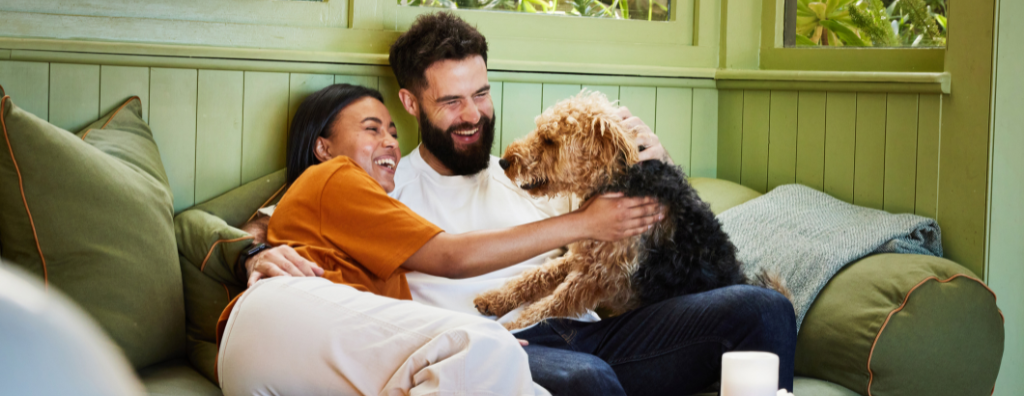
For many of us, pets are important members of our household, which means our homes should be as comfortable for them as they are to everyone else who lives there. When choosing how to decorate your home, whether you’re moving into a new one or welcoming a new furry or feathered friend into the one you already live in, thinking ahead about their needs can not only create a happy space for everyone but also help with the inevitable pet-related accidents and other possible issues down the road.
Cuddly-friendly Furniture
While some pet owners refuse to let animals on couches or chairs, others love to cuddle with their furry friends on or near their laps. If you fall in with the first group, create a soft space on the floor for Fido or Fluffy to lie on when the family is relaxing. Dog and cat beds come in just about every material, color, and style you can imagine, so finding one that fits in with your aesthetic should be relatively simple.
If you’re in the second group, select furniture that can withstand the wear and tear of claws, accidents, and frequent vacuuming. Leather (or faux leather) surfaces are best for homes with animals that shed. If you prefer the feel of fabric instead, choose a couch or loveseat made from stain-resistant materials or use a washable slipcover.
Throw blankets are not only cozy, but they are also great for creating a barrier between pets and furniture, and they’re a lot easier to clean than an entire couch.
Safe Plants
Incorporating live plants and greenery is a great way to add a touch of nature to your home’s interior, but not all plants are safe for pets. While fake plants are an option, they don’t provide the extra benefit of helping to clean the air you breathe while indoors.
Rattlesnake plants, spider plants, orchids, many kinds of fern, and small palms are all beautiful additions that aren’t toxic if your pup or kitten takes a nibble. There are also many types of succulents that are pet-safe, and the spiny ones will deter a pet that’s looking for a snack or—in the case of some cats—a litter box.
Flooring
When it comes to pets, accidents are usually inevitable. As well behaved and trained as they may be, pets get sick, old, and stressed. Though messes are bound to happen, lingering stains don’t have to. Hardwood, tile, and vinyl floors make it easy to wipe up anything your pet leaves behind, as well as spills they may cause. Washable rugs come in dozens of attractive styles and are great at protecting floors, especially if you add a pet-proof pad underneath. Put plastic or vinyl mats under pet feeding areas to protect floors from spills and to prevent bits of food from spreading throughout the house.
Colors
The best way to camouflage pet hair in between sweeping and vacuuming is to select furniture, carpets, and décor items that match your pet’s coat. If you’ve got a brindle pup, calico kitty, or multi-colored animal friend, patterns will be your best bet. Florals, plaids, stripes, paisleys, and other patterns also help hide stains when those inevitable spills and accidents happen.
Hidden Essentials
Our animal buddies are sweet, cute, and cuddly, but not everything about having a pet is attractive. Litter boxes, feeding stations, and sleeping crates take up a lot of room and can be eyesores. Fortunately, furniture makers have taken notice and created pieces that are both aesthetically pleasing and functional.
For indoor kitties, litter boxes are necessary, but constantly seeing and smelling them isn’t. Get the box out of sight with a stylish litter box side table. Dogs can nap in style with a crate that doubles as an end table or nightstand. Feeding stations with storage make dinner time easy and keep unsightly bags of food hidden away.
Your love of animals doesn’t have to get in the way of living in style. These tips should help you find the right balance between the two.
Decorating for a Stress-Free Home

Your home should be your sanctuary—a place to relax, spend time with loved ones, and unwind from the stresses of everyday life. But with many of us working from home, even partially, the lines between life and work can become blurry. And with other stressors bleeding over into personal time, home can start to feel less like a sanctuary and more like the focal point for life’s anxieties.
If you are looking to reduce stress when you’re home and turn your space back into a place of respite, a few DIY redecorating projects could do the trick.
Lighting
How we light our homes (and when we turn the lights off) can have an enormous impact on our mental health. Natural light from unobstructed windows is ideal for boosting your mood during the day, but if you don’t have many windows or prefer your privacy, lamps that produce warm light can be soothing.
Getting a good night’s sleep is one of the best ways to manage stress. Once the sun sets, dim the lights in your house and use blackout curtains to achieve full darkness while you sleep. Avoid lightbulbs that claim to mimic daylight unless you are using them for Seasonal Affective Disorder in the winter months.
Décor idea: Turn off overhead lighting and invest in lamps with variable or dimmable light settings.
Declutter
Though some homeowners are bucking the trends for simple and opting for a “maximalist” style, clutter stresses many of us out. You can go through your house and get rid of all the items that aren’t sparking joy, or you can invest in attractive storage systems that allow you to hold onto your things while keeping them organized. At the very least, make sure you don’t have “to do” stacks or piles in the bedroom.
Décor idea: Try a flip-top bench in hallways or at the foot of your bed to hide away infrequently used items.

Example of a clean bedroom with warm lighting and a bench at the foot of the bed. Image Source: AI Generated Image for Inspiration Only
Feng Shui
The ancient art of Feng Shui has been helping people create calm inside their homes for thousands of years. Whether or not you believe that sleeping with the head of your bed on the north wall of the bedroom promotes deeper sleep, it’s hard to argue with other Feng Shui practices. One such principle is bringing nature indoors. This can be accomplished with living plants or even art featuring wilderness landscapes.
Décor idea: Select one wall in your home and devote it to photographs of living plants or natural settings.
Rounded shapes
Though clean lines and order may feel comforting to some, too many right angles can be overly stimulating. Circles and ovals, on the other hand, feel more organic and soothing. While you may not be able to round out the corners or entry ways in your home, you can add round touches with circular ottomans, oval frames for mirrors and art, and spherical elements such as a globe or orbs on a bookshelf.
Décor idea: Consider wallpaper or wall designs the include flowing, organic shapes such as wood grain or florals.
Color
The hues and shades you use in your home can have the biggest impact on your mood. Bright colors can be energizing, and reds are great for stimulating appetites in kitchen and dining rooms. But if you are looking to bring a sense of calm to a room, muted shades of blue and green or earth tones are best. Don’t mistake “muted” for “light” though; deep ocean blues and forest greens can be soothing while still making a statement.
Décor idea: If you’re hesitant to commit to painting a whole room, experiment with calming colors by incorporating throw blankets, pillows, and artwork.
Creating Space for a Stress-Free Zone in your Home
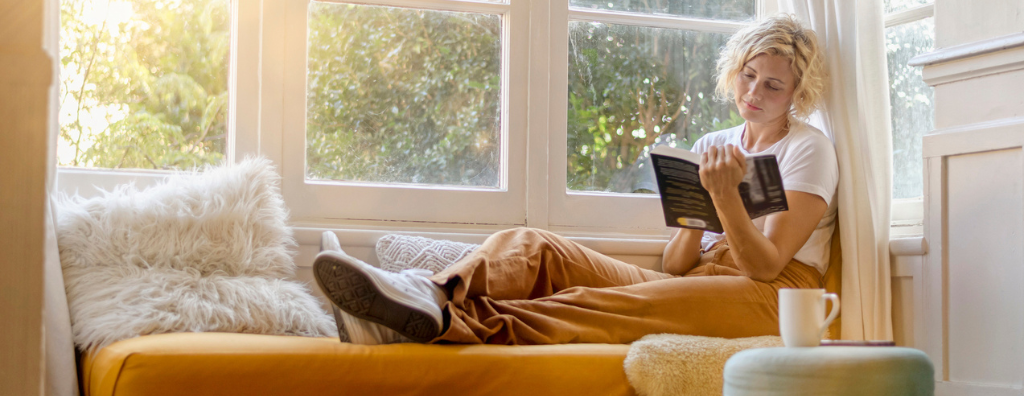
The meaning of home has expanded over the years, adding new activities beyond eating and sleeping. For many this means home has more space to work and do hobbies. But as those things expanded, the feeling of relaxation may have dwindled, and for those struggling with the mental health implications of this, creating a space in your home that is dedicated to reducing stress could be the ticket to achieving a sense of peace and calm. Whether you use that space to meditate, exercise, or read, having a place in your home to focus on your mental health can change the way you show up for yourself and the important people in your life.

Image Source: Getty Images Lytvyn
Fitness Corner
If exercise is your chosen route to improved mental health, a small home gym could be right for you. How you set up your fitness space will depend on your preferred form of exercise, as well as your budget.
If your routine requires a treadmill or indoor bicycle, make that the focal point of your space. If yoga, Pilates, or barre is more your speed, you’ll need room to unroll a mat and move freely. Weightlifting or body-weight exercises might necessitate more space and equipment but are both feasible even in a corner of your office or a walk-in closet.
Regardless of how you plan to get your sweat on, use nearby wall space for shelving or hooks to store equipment. This could range from light hand weights and exercise bands to jump ropes and yoga mats. If you need more storage, find furniture that serves multiple purposes. For example, a cabinet that stores towels can also double as a surface for a small fan and your water bottle.
For extra motivation to spend time in your exercise area, add a little personalization. Wallpaper or bold paint colors not only add visual interest, but they also create a sense of separation from the rest of the room or area. Soothing art and living plants are particularly apt for spaces dedicated to yoga.
Meditation Space
Meditation is a great way to calm the mind, and you don’t need special equipment or a lot of room to do it. Creating your own meditation space can be simple, quick, and doesn’t require a large investment.
Start by finding a place in your house that is as free from distractions as possible. This could be a corner in your bedroom or a section of your backyard or terrace. Ideally the space would be near a window or natural light source.
Where and how you sit can make or break a meditation session. A chair, meditation cushion, or yoga mat that allows you to sit comfortably for several minutes while keeping you alert will do the trick.
If you plan to listen to guided meditations or music, a small Bluetooth speaker can be a good option if you want to avoid using headphones and will have better sound quality than listening from your phone’s speaker.
Though many people prefer to meditate with their eyes fully closed, visual elements can help set a serene scene. Plants, candles, statues, and art can also add a sense of your personality. If clutter stresses you out, keep your decor clean and minimalist. You can include your other senses in your meditations by adding a water feature and burning incense or essential oils.

Image Source: Getty Images JulieAlexK
Reading Nook
If getting lost in a good book is your favorite way to unwind, a reading nook will quickly become your favorite spot at home.
Whether you’ve got a corner or a closet to dedicate to the space, the key to hours of reading enjoyment is the right seating. It’s hard to beat the traditional wingback or club chair, but smaller spaces might call for more creative ideas. Floor cushions, padded benches, bean bag chairs, and hammocks are all options.
Once you’ve got your sitting area situated, lighting comes next. A location near a window that brings in natural light is ideal, but for those who love to read late into the night or who don’t have a window nearby, standing or table lamps and wall sconces will save you from eye strain.
If you’ve got the space, a side table for cocoa, coffee, or tea is a nice addition. It’s also a great area for that mile-high “to be read” pile book lovers are known for. Even better if it’s got a drawer for bookmarks, reading glasses, pens, and notebooks.
For extra coziness, add a throw blanket or shawl and some cushy pillows.
Make these ideas come to life, check out our Pinterest board for inspiration.
Pantone 2024 Color of the Year: How to Use Peach Fuzz in your Home
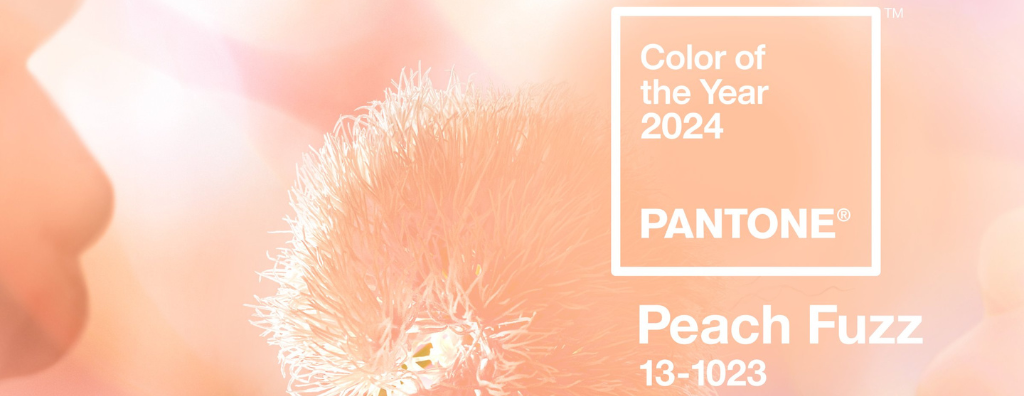
The global color experts at Pantone have spoken, announcing the 2024 Color of the Year to be “Peach Fuzz.” Leatrice Eiseman, the Executive Director, Pantone Color Institute shared this explanation on the website, “in seeking a hue that echoes our innate yearning for closeness and connection, we chose a color radiant with warmth and modern elegance.”
The gentle color brings to mind an embrace that’s calm and nurturing. Reminiscent of the sun on the horizon, or a fruity drink that promises refreshment, Peach Fuzz has a lot of potential in our homes this year.
Pantone Color of the Year: Peach Fuzz
Peach Fuzz is a light pink-orange hue and is described by Pantone Color Institute as subtly sensual, calm, and comforting. Chosen because of its ability to conjure feelings of tenderness, community, and collaboration, PANTONE 13-1023 Peach Fuzz is as modern as it is vintage and “reflects the past yet has been refashioned with a contemporary ambience,” making it accessible for homes and décor of any decade.
How to Use Peach Fuzz in Your Home
While recent trends have leaned into the monochrome look, Peach Fuzz is versatile in palettes that range from earthy to colorful to neutral. The warm hue can be integrated with a variety of existing décor styles and is only restrained to the homeowner’s preferences.
Using Peach Fuzz with an Earthy Aesthetic
If you’ve already developed a warm palette in your space using earthy browns, greens, and blues, Peach Fuzz can offer warmth and interest. Similar to that pink-orange golden hour that casts a warm light across the landscape, this color of the year can bring sunshine to your space through glass elements like candle sticks, vases, and pendant lights.
Consider lighting your space with tapered candles in transparent orange candle stick holders, or tea lights in short peach hurricanes. Or hang a light with an orange pendant to diffuse the lightbulb and bring that sunset look inside your home all evening. Peach vases are another option to combine your love of nature with the sunny warm hue. Consider a translucent glass vase, or maybe one shaped like a mushroom.
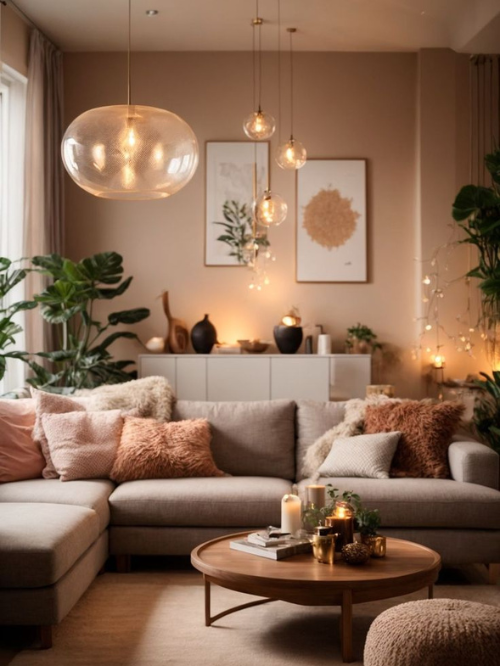
Image Source: Naseem designer on Pinterest
Adding Peach Fuzz to a Colorful Room
Do you prefer a colorful approach to your home’s décor? Peach Fuzz can add a lovely backdrop to help gemstone colors pop out even more. Any good palette is a balancing act, and this peach color can sway that balance supporting your jewels and highlighting their rich shades. Add PANTONE 13-1023 Peach Fuzz to your background pieces, like throw blankets, rugs, and walls, then layer your gemstone pieces atop.

Image Source: Hunker on Pinterest
Peach Fuzz in a Neutral Room
Many homeowners find that a neutral palette of light and warm off-whites, beiges, and natural woods is more pleasant and easier to maintain. If your home enjoys this minimalist simplicity, and you would like to add another warm color to your aesthetic, Peach Fuzz may be the right one for you.
Adding throw blankets and pillows is a great way to add color to your neutral room, as is replacing your rug with one that includes the pink-orange color in the design. You may also consider swapping out some decorative pieces like coffee table books, vases, and figurines for Peach Fuzz colored replacements.
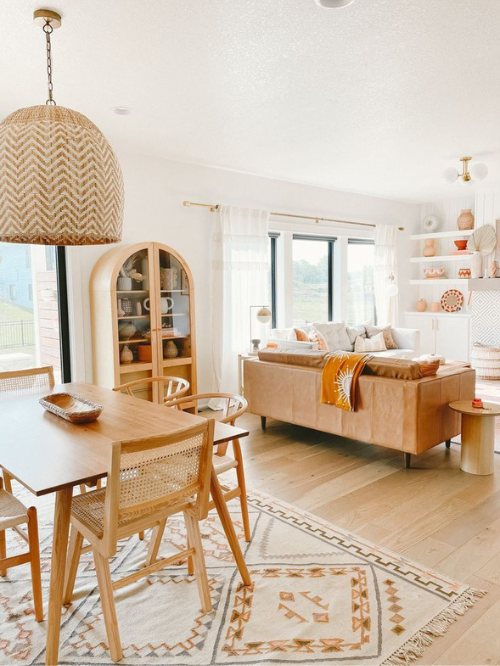
Image Source: Brighten Made on Pinterest
9 Options to Remove, Hide or Play Down a Popcorn Ceiling
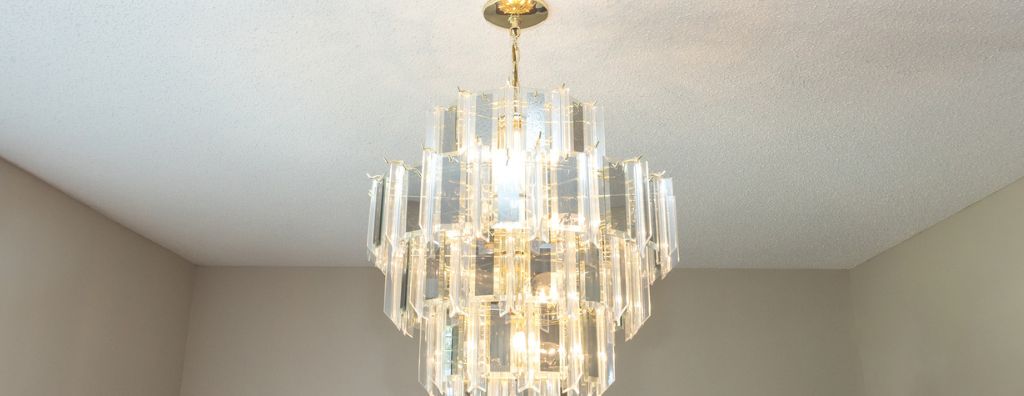
Don’t love your popcorn ceiling? You’re not the only one stuck with some unwanted stucco overhead. There are many options for moving on from it, but not all of them are equally effective — or equally easy. To help you decide how to address your popcorn problem, here are some top ways to remove, cover or distract from stucco ceilings.
5 Features of Traditional Interior Design
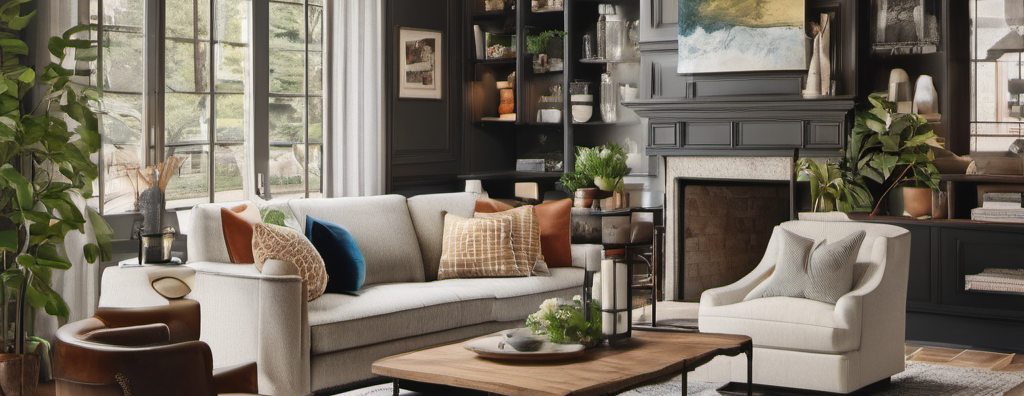
There is perhaps no other home décor style as comforting as traditional interior design. Rooted in the masterfully crafted Chippendale and Thomas Sheraton furniture designs and classic Queen Anne colors, traditional décor is one vintage style that stood the test of time. Here are five distinct features of traditional interior design.
5 Features of Traditional Interior Design
1. Dark Wood Finishes
Part of the reason for traditional design’s timeless appeal is its use of woodworking. With woodwork as a foundation, this design style feels classic but not dated. The dark, bold colors resemble the Victorian style, but traditional interiors are simpler and less ornate. The dark tones of the wood create a foundation for a more colorful decorative palette.

Image Source: AI Generated image in Traditional Interior Design Style – for inspirational use only
2. Traditional Design Color Palette
Traditional design can handle a heavier color palette while still providing comfort. The darker wood tones allow for darker color to be used elsewhere throughout a space, such as dark window coverings. Floral, plain colors, and muted plaids are all common color schemes. Walls are often covered with patterned wallpaper, floral designs, or damask. In terms of designs, traditional interiors pair well with geometrics and small, striking yet understated patterns.
3. Hardwood Flooring
This design style is classic from the floor to the ceiling. You won’t find laminate or tile flooring in the common areas of a home that adheres to the principles of traditional interior design. Complimenting the surrounding woodwork, homes designed in this style have solid hardwood flooring. How to Choose the Best Flooring

Image Source: AI Generated image in Traditional Interior Design Style – for inspirational use only
4. Traditional Decorations
The decorations used in traditional design help to reinforce its unique, classic-yet-comfortable ambiance. Table lamps and vases are typical of a traditional interior, often displayed in pairs to create symmetry. Though these accessories are bold, they are never too ornate or over-the-top enough to dominate the room.
5. Design Philosophy
Traditional design is calm and orderly. Whereas a more eclectic interior design style may offer more surprises throughout its spaces, a traditional interior is more predictable. Even the textiles used are subtle, with typical materials ranging from cotton and fur to velvet and silk.
For more inspiration and interior design tips, visit the Design category of our blog:
Featured Image Source: Getty Images – Image Credit: irina88w
DIY Nursery Décor: 5 Tips for Renters
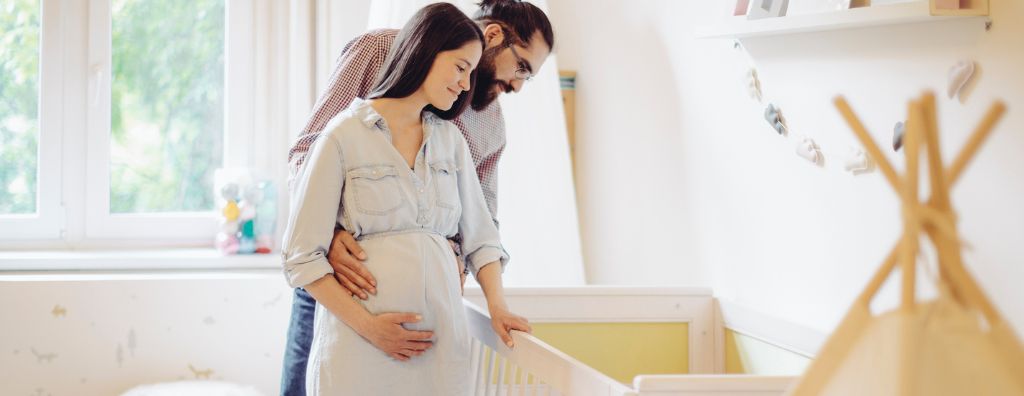
Prepping for parenthood? There are so many exciting changes on the horizon, but one change you’ll need to make at home is making sure you have a nursery all set up for your little one. As a renter, you may not have a ton of extra space to work with and you may also be limited by how many aesthetic changes you can make, but with the right guidance and a little creativity, your DIY nursery décor efforts can soar.
Nursery Preparation
Before you get into the design details, you need to choose a location for your nursery. Ideally, it will be close enough to your bedroom that you can quickly give your newborn the attention they need. To properly childproof your home, remove all unnecessary items from the nursery. Properly decluttering the area will help you prioritize safety. For more tips on childproofing your home, visit the U.S. Consumer Product Safety Commission online: Childproofing Tips – CPSC
DIY Nursery Décor
1. Creative Storage Ideas
As a renter, you’ve likely gotten practice maximizing space at home. Storage in the nursery will help to keep everything tidy while making sure that the things you and your child needs are never too far away. Floating shelves and wall-mounted organizers are two popular choices for making the most of vertical space. Be sure to check your lease and talk to your landlord before drilling into the walls to prevent permanent damage. Keep all toys, diapers, and baby-related accessories in easily reachable baskets, stored either underneath the bed or in the closet.
2. Nursery Color Palette
Let your imagination run wild with color design ideas for painting and decorating. Add splashes of colors in the window curtains, pillows, bedding, carpeting, and other accessory items throughout the room. You can also consider removable wallpaper to refresh the room. If you are decide to re-paint, use an indoor paint calculator to determine how much paint you’ll need and to cut down on wasted material.
3. Light and Dark
Finding the right lighting for your home is a room-by-room journey. The kitchen, for example, has different lighting needs than your cozy reading nook. Your nursery is a unique area when it comes to proper lighting. To create a calm atmosphere, choose soft, warm-temperature lamps with dimmers. This allows you to adjust the lighting levels to fit the time of day (or night). Less harsh light is easier on a newborn’s eyes and can make for less of a headache when you’re waking up multiple times a night. Babies also need lots of rest, so it’s important to install heavy curtains that block out sunlight and allow your little one to drift into deep sleep.
4. Bring Nature Indoors
Incorporating nature at home has aesthetic benefits, of course, but it’s also good for your health. Using organic materials, house plants, and earthy accessories can help you breathe easier and lower your stress levels at home. Consider adding small potted plants along the windowsill, installing a mobile with a touch of nature, or even incorporating a small water feature in the room to encourage serenity. A nature-infused nursery will help you relax your mind so you can take each at-home parenting step in stride. To further align your nursery’s design with the rest of your home, learn about which house plants match with different interior design styles.
5. Create a Gallery Wall
You’ll create many memories in your nursery. Who knows? It could be the room where your child takes their first steps or utters their first word. Use wall space creatively by creating a gallery wall with adhesive strips to minimize damage to the walls. You can add personal photos and keep track of special memories made with your family at home. Consider a corkboard or magnetic whiteboard to pin up new memories in sight as well.
For more info on home décor, remodeling tips and more, visit the Design category of our blog:
Featured Image Source: Getty Images – Image Credit: Eva-Katalin
How Much Paint Do I Need? Indoor Paint Calculator
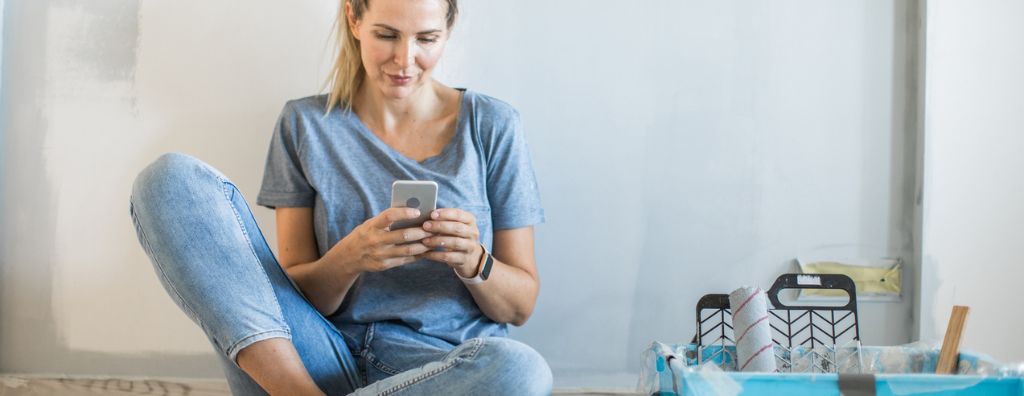
Whether you’ve just bought a house or you’ve lived in your home sweet home for years, at some point its walls and surfaces will be due for a fresh coat of paint. Repainting can breathe new life into an interior and help you personalize the space, whether you’re working within the latest interior design trends or blazing your own trail. But there’s one fundamental question facing every homeowner as they begin their painting project: How much paint do I need?
How much paint do I need?
Every project has a budget, and with the right planning you can execute the project to its full potential without going over budget. Painting is the ultimate DIY project and can be quite therapeutic, but still requires some calculation to determine how much you should expect to spend. With the right amount of paint, you’ll avoid overspending and getting saddled with the sunk cost of unused paint after you’ve completed your project.
The amount of paint required varies by project, but as a general rule of thumb, one gallon of paint covers about 400 square feet. So, it only takes a few simple measurements to calculate the amount of paint you’ll need for your walls.
How to Calculate How Much Paint You Need:
- Start by measuring the length of each wall
- Multiply the wall length by the wall height
- Total length x total height = total square footage
- Total square footage ÷ 400 = number of gallons
- Subtract windows and doors square footage
Following this formula will give you the number of gallons you need to purchase for one coat of paint. Depending on your color scheme and the texture of your walls, your painting project may require multiple coats to have it looking just right.
If the walls you’re painting have windows and/or doors, simply perform the same basic calculation to determine their square footage and subtract that number from the total square footage value before calculating how many gallons you’ll need. When painting your ceilings, remember to account for the square footage of any skylights you may have in your home.
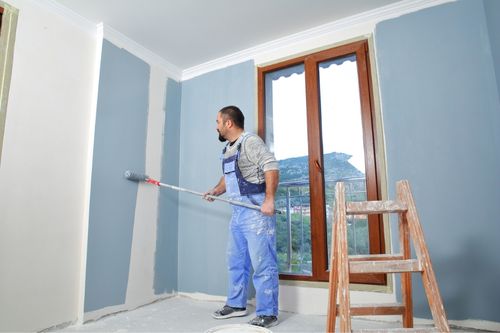
Image Source: Getty Images – Image Credit: aydinmutlu
Primer and Trim
It’s often the case that a paint job is only as good as its base coat. A solid layer of primer can really make your painting project shine. But the same query with your topcoat applies to your primer: how much do you need? A gallon of primer will cover up to 300 square feet, so you’ll need more primer than topcoat for your project. Perform the same calculations as above and divide your paintable square footage by 300 to determine how many gallons of primer you’ll need to pick up.
How to Calculate How Much Primer You Need:
- Start by measuring the length of each wall
- Multiply the wall length by the wall height
- Total length x total height = total square footage
- Total square footage ÷ 300 = number of gallons
- Subtract windows and doors square footage
Calculating square footage for trim isn’t as straightforward as it is for a square or rectangular wall. When preparing to paint your baseboards and crown molding throughout your home, think in quarts rather than gallons. Trim paint may go on smoother depending on the wood finish, and you’ll be using a brush rather than a roller. If you end up with extra trim paint at the completion of your project, it never hurts to keep it around for future touchups.
For more information on DIY projects, home design and more, visit the Design page of our blog:
Featured Image Source: Getty Images – Image Credit: svetikd
Pantone 2023 Color of the Year: How to Use Viva Magenta in Your Home

Another year, another statement from the Pantone Color Institute, the leading authority on all things color design. The global color expert recently announced their Color of the Year for 2023: Viva Magenta. A beautiful hue of the red family, it is vibrant and soothing at the same time. Just like last year’s selection, Very Peri, it captures common feelings shared by modern homeowners while presenting a bounty of creative design solutions. Learn a bit more about this special color and how you can incorporate it into your home.
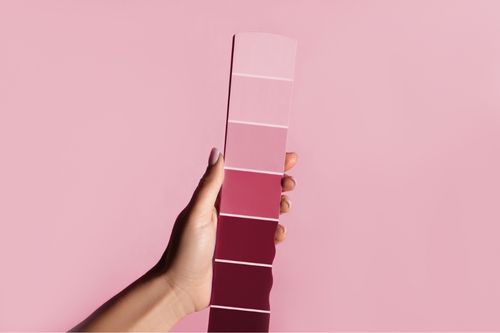
Image Source: Getty Images – Image Credit: YakubovAlim
Pantone Color of the Year 2023: Viva Magenta
Viva Magenta is a bright, crimson red that balances warm and cool energy. Pantone describes the color dynamically, calling it “fierce” and “rich.” They say it differs from last year’s selection in that Viva Magenta answers our “collective need for strength.” So, what does this mean for you as a homeowner? Viva Magenta is a color of unity. It has the power to embrace and make your guests feel welcomed while maintaining a modern aesthetic. Colors in the red family are known to make a home feel comfortable, especially in the dining room. It has often been said that reds can stimulate appetite.
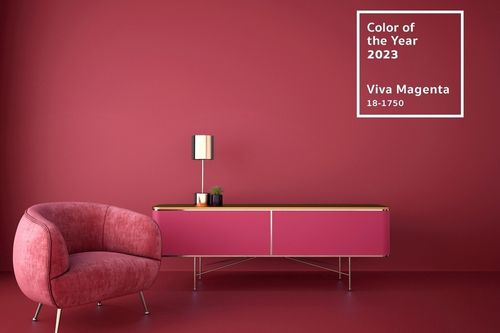
Image Source: Shutterstock – Image Credit: Ume Illustration
How to Use Viva Magenta in Your Home
This year’s interior design trends are showing a preference for colorful decorating. Viva Magenta fits this mold perfectly. It is a bold and vivacious choice for interior paint. Need a splash of energy in the living room? Looking to give your dining room a makeover? Viva Magenta may be the perfect solution.
In terms of complementary colors, Pantone specifically calls out pale grays, blues, and pastels. This shade of magenta can be a stunning accent color for homeowners that prefer a more neutral backdrop while incorporating elements of contemporary home design. The typical accent pieces come to mind: pillows, blankets, and throw rugs. However, Viva Magenta is also perfectly suited for accent items in the kitchen—think glassware, candle holders, hand towels, etc. For those who are ready to dive into the deep end of the magenta pool, consider a velvet couch. Its boldness also goes well with interior design styles that are characterized by flair, such as Art Deco interior design.
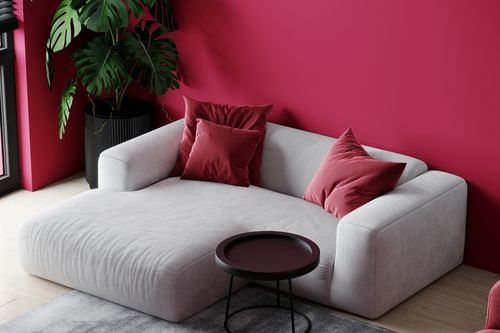
Image Source: Shutterstock – Image Credit: Viktoria Lytvyn
Viva Magenta is sure to lead the eye throughout your home. Its magnetic energy may be the missing ingredient to your interior design plans for 2023. For more information on color design tips, read our blog post on Colorful Modern Design Trends for Your Home.
Featured Image Source: Shutterstock – Image Credit: sommthink
 Facebook
Facebook
 X
X
 Pinterest
Pinterest
 Copy Link
Copy Link


